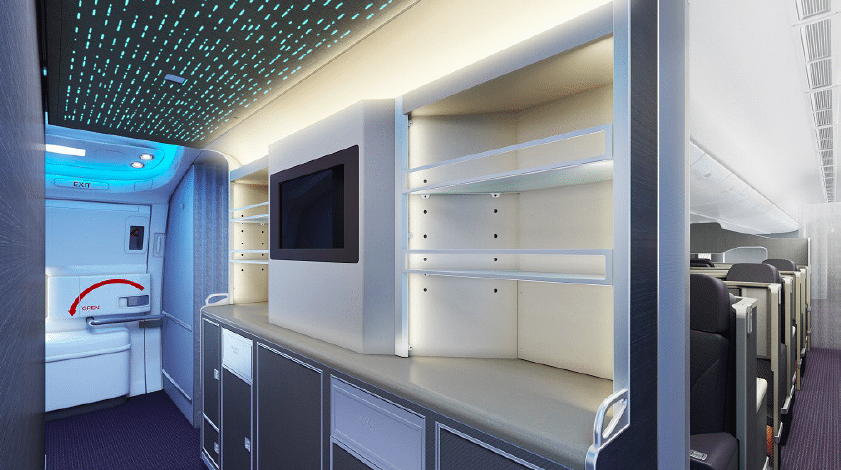Skift Take
A greater focus on enhancing the overall cabin experience, taking into account all factors which affect passenger comfort, far beyond issues of seat space and pitch, will make the cabin a significantly more pleasant space in the very near term.
To the degree that a cabin continues to be no more than a comfortable illusion artfully created within a volatile high-speed cylinder flying high above the clouds, the laws of physics and the laws governing airline safety will continue to limit just how far airlines can go with their greatest ambitions.
Tomorrow’s airline will still consist of a confined space, with seating complemented by niceties.
But, oh! How nice those niceties could be.
By opening up the possibilities of the cabin for further innovation, thinking of the product in an entirely different way, leaving behind a past sectioned by two or three or even four carefully structured cabins, airlines have an opportunity to completely reinvent themselves, redefine air travel, and win back the hearts of customers at all budget levels.
We’ve all seen plenty of Premium activity so far this year, and there is plenty of reason to believe we’ll see even more. Given the restrictions of aviation, there really is only so far you can take the front from here. We’re waiting for something really exciting—the revolutionary developments possible for those sitting on the other side of the gilded curtain.
Experts would like to see airlines take advantage of the opportunities cross-branding presents, such as that between hotels and airlines. “Partnerships in co-branding design,” Devin Liddell, Principle Brand Strategist at Teague, tells us, “link the seams within the travel experience.”
By extending the alliance concept beyond airlines and to ground-based brands, capitalizing on relationships already built through loyalty programs, then bringing cross-branding into the cabin, airlines put themselves at an advantage while providing their customers a familiar and reliable family of products throughout the journey.
And that is the future. “A holistic branded journey,” Liddell says, “will see the seams wrapped up in twenty years time.” Liddell suggests that this will fix design and brand in the memory of passengers. With service enhancements, possible only through collaboration, the passenger experience can be considerably enhanced. “I see a future where an airline express transfers bags directly to the passengers’ room at the hotel.” Liddell also suggests that the air-to-ground service could extend to allowing a passenger to finish the movie she began to enjoy onboard, at her hotel room—where she would find it cued up to play through to the end whenever she’d like.
Liddell and others agree that this is where we’re headed, and both see many ways in which cross-branding could be effective. Christopher Nurko, Global Chairman at FutureBrand, even suggests that brands having nothing to do with travel, yet associated with luxury could contribute to the cabin. Nurko recommends that airlines consider “an experimentation of the cabin mirrored on the ground,” referring to the introduction of luxury elements, which are already part of the passengers’ surroundings and every-day experience, into an airline’s cabin planning.
As Nurko says, brands like Bulgari have already found their place on the aircraft, if only sneaking in through the amenity kit. Co-branded amenity kits are just a hint of the possibilities for airlines to earn revenue and/or recover development costs for cabin designs. By taking a co-branding concept to its extreme evolution, airlines could, for example, have their costs for elements of trim and finish (fabrics, décor) and soft products (bedding, amenity kits, pyjamas, meals, entertainment content) paid for by brands which would benefit through the association.
By suggesting that airlines design for the extremes, Liddell also sees possibilities in co-branding. “In general,” he tells us, “there’s not enough emphasis on service and product distinction.” An opportunity to provide great distinction is to effectively apply brand collaboration.
Yes, there could be Louis Vuitton First Class suites. There could also be Millennial-focused rows at the back offering free connectivity and music streaming, courtesy of Apple. There could be Happy Meals in the Family cabin for the kiddies. Starbucks could offer everything from Lattes to Teavana, from scones to healthy sandwich options, to those Gen-TREP passengers in a dedicated Connected cabin. Beautyrest could sponsor special bedding and more comfortable seat cushions for a Rest Zone cabin, where frequent flyers can work without noise disruptions and sleep uninterrupted. These are only a few of the myriad possibilities for airlines and brands to explore. The industry is at a critical point to begin this dialogue and make these brand alliances. Doing so will keep it relevant and refreshing for a long time to come.
One thing is certain, the flying experience as a whole, as supported by trends at the the world’s airport terminals, is changing and will continue to change. The changes may surprise us—and they ought to. Aviation as we know, thanks to its democratization, has lost its novelty. To bring that novelty back and make a profit, airlines will need to think beyond the seat.
The Daily Newsletter
Our daily coverage of the global travel industry. Written by editors and analysts from across Skift’s brands.
Have a confidential tip for Skift? Get in touch
Photo credit: American Compensates for the lack of a lounge on the 777-200 by providing an attractive walkup bar, which also serves to disguise unattractive galleys and is a better welcome on board for passengers–that’s hospitality well applied. American Airlines
